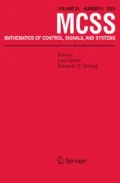Abstract
Difference inclusions provide a discrete-time analogue of differential inclusions, which in turn play an important role in the theories of optimal control, implicit differential equations, and invariance and viability, to name a few. In this paper we: (i) introduce a framework suitable for the study of difference inclusions for which the state evolves on a manifold; (ii) use this framework to develop necessary conditions for optimality for a broad class of discrete-time problems of dynamic optimization in which the state evolves on a manifold M. The necessary conditions for optimality we derive include the case for which the state \(q_i\) is subject to constraints \(q_i \in S_i \subseteq M\), for \(S_i\) a closed set. The resulting necessary conditions for optimality appear as discrete-time versions of the Euler–Lagrange inclusion studied by Ioffe (in Trans Am Math Soc 349(7):2871–2900, 1997), Ioffe and Rockafellar (in Calc Var Partial Differ Equ 4(1):59–87, 1996), Mordukhovich (in SIAM J Control Optim 33(3):882–915, 1995), Mordukhovich (in Variational analysis and generalized differentiation II: applications. Springer, Berlin, 2006), and Vinter and Zheng (in SIAM J Control Optim 35(1):56–77, 1997) generalized in a natural way to the case in which the state is evolving on a manifold.
Similar content being viewed by others
Notes
It can be shown through the implicit function theorem that for any compact neighborhood K of \(0 \in \mathbb {R}^3\) there exists \(\delta > 0\) such that F is well-defined and smooth for all \(0< h < \delta \) and \({\Pi } \in K\). It is standard to suppose that time step h is chosen small enough so that F is well-defined for \(({\Pi },h)\) occurring in the update scheme described above and we also make this assumption.
References
Absil PA, Mahony R, Sepulchre R (2007) Optimization algorithms on matrix manifolds. Princeton University Press, Princeton, NJ
Agrachev AA, Sachkov YL (2004) Control theory from the geometric viewpoint. Springer, Berlin
Assif M, Chatterjee D, Banavar RN (2018) A simple proof of the discrete time geometric Pontryagin maximum principle. arXiv e-Print
Aubin JP, Cellina A (1984) Differential inclusions: set-valued maps and viability theory. Springer, Berlin
Borwein JM, Zhu QJ (2005) Techniques of variational analysis. Springer, New York
Clarke FH (2013) Functional analysis, calculus of variations and optimal control. Springer, London
Clarke FH, Ledyaev YS, Stern RJ, Wolenski PR (1998) Nonsmooth analysis and control theory. Springer, New York
Duistermaat JJ, Kolk JAC (2000) Lie groups. Springer, Berlin
Gao Z (2004) On discrete time optimal control: a closed-form solution. In: Proceedings of American control conference. IEEE, pp 52–58
Gupta R, Kalabić UV, Di Cairano S, Bloch AM, Kolmanovsky IV (2015) Constrained spacecraft attitude control on SO(3) using fast nonlinear model predictive control. In: Proceedings of American control conference, pp 2980–2986
Hájek O (1979) Discontinuous differential equations, I. J Differ Equ 32(2):149–170
Herz C (1991) The derivative of the exponential map. Proc Am Math Soc 112(3):909–911
Iglesias-Ponte D, Marrero JC, Martín de Diego D, Padrón E (2013) Discrete dynamics in implicit form. Discrete Contin Dyn Syst A 33(3):1117–1135
Ioffe AD (1997) Euler–Lagrange and Hamiltonian formalisms in dynamic optimization. Trans Am Math Soc 349(7):2871–2900
Ioffe AD, Rockafellar RT (1996) The Euler and Weierstrass conditions for nonsmooth variational problems. Calc Var Partial Differ Equ 4(1):59–87
Kalabić UV, Gupta R, Di Cairano S, Bloch AM, Kolmanovsky IV (2017) MPC on manifolds with an application to the control of spacecraft attitude on SO\((3)\). Automatica 76:293–300
Kipka RJ, Gupta R (2017) The discrete-time geometric maximum principle. arXiv e-Print
Kobilarov MB, Desbrun M, Marsden JE, Sukhatme GS (2007) A discrete geometric optimal control framework for systems with symmetries. In: Proceedings of robotics: science and systems
Kobilarov MB, Marsden JE (2011) Discrete geometric optimal control on Lie groups. IEEE Trans Robot 27(4):641–655
Ledyaev YS, Zhu QJ (2007) Nonsmooth analysis on smooth manifolds. Trans Am Math Soc 359(8):3687–3732
Lee JM (2012) Introduction to smooth manifolds. Springer, New York
Lee T (2008) Computational geometric mechanics and control of rigid bodies. Ph.D. thesis, University of Michigan
Lee T, Leok M, McClamroch NH (2007) Lie group variational integrators for the full body problem. Comput Methods Appl Mech Eng 196(29):2907–2924
Lee T, McClamroch NH, Leok M (2005) A Lie group variational integrator for the attitude dynamics of a rigid body with applications to the 3D pendulum. In: Proceedings of conference on control applications, pp 962–967
Marsden JE, West M (2001) Discrete mechanics and variational integrators. Acta Numer 2001(10):357–514
Mordukhovich BS (1984) Nonsmooth analysis with nonconvex generalized differentials and conjugate mappings. Doklady Akademii Nauk Belarusi 28:976–979
Mordukhovich BS (1995) Discrete approximations and refined Euler–Lagrange conditions for nonconvex differential inclusions. SIAM J Control Optim 33(3):882–915
Mordukhovich BS (2006) Variational analysis and generalized differentiation I: basic theory. Springer, Berlin
Mordukhovich BS (2006) Variational analysis and generalized differentiation II: applications. Springer, Berlin
Phogat KS, Chatterjee D, Banavar RN (2018) Discrete-time optimal attitude control of spacecraft with momentum and control constraints. J Guid Control Dyn 41(1):199–211
Phogat KS, Chatterjee D, Banavar RN (2018) A discrete-time Pontryagin maximum principle on matrix Lie groups. Automatica 97:376–391
Schirotzek W (2007) Nonsmooth analysis. Springer, Berlin
Vinter R, Zheng H (1997) The extended Euler–Lagrange condition for nonconvex variational problems. SIAM J Control Optim 35(1):56–77
Acknowledgements
The work presented in this paper was initiated, while the second author was a postdoctoral fellow at the Institute for Mathematics and its Applications (IMA) during the IMA’s annual program on “Control Theory and its Applications.”
Author information
Authors and Affiliations
Corresponding author
Additional information
Publisher's Note
Springer Nature remains neutral with regard to jurisdictional claims in published maps and institutional affiliations.
Rights and permissions
About this article
Cite this article
Kipka, R., Gupta, R. A geometric approach for the optimal control of difference inclusions. Math. Control Signals Syst. 31, 1–27 (2019). https://doi.org/10.1007/s00498-019-0231-y
Received:
Accepted:
Published:
Issue Date:
DOI: https://doi.org/10.1007/s00498-019-0231-y


